The Potteries of Stoke-on-Trent
by Richard Crowhurst
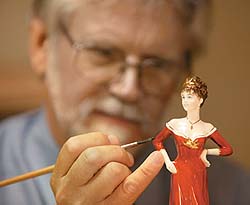 Before I begin this piece in earnest, I think it's
only fair to tell you two things. Firstly, Stoke-on-Trent is not
the destination of choice for those looking to spend a weekend in
picturesque surroundings. While I might have just offended the
good inhabitants of the city with this statement, it has to be
said that, taken as a whole, this is far from the prettiest place
in England. So why visit? I'll come to that in a minute, but
there's something else you should know before you pack your
weekend bag. The city of Stoke-on-Trent is a modern invention,
one that didn't exist before 1910. Today's city is a
conglomeration of six separate towns (and a couple of villages,
such as Etruria), that are collectively known as The Potteries.
Individually they are Burslem, Fenton, Hanley (the city centre),
Longton, Stoke and Tunstall. Before I begin this piece in earnest, I think it's
only fair to tell you two things. Firstly, Stoke-on-Trent is not
the destination of choice for those looking to spend a weekend in
picturesque surroundings. While I might have just offended the
good inhabitants of the city with this statement, it has to be
said that, taken as a whole, this is far from the prettiest place
in England. So why visit? I'll come to that in a minute, but
there's something else you should know before you pack your
weekend bag. The city of Stoke-on-Trent is a modern invention,
one that didn't exist before 1910. Today's city is a
conglomeration of six separate towns (and a couple of villages,
such as Etruria), that are collectively known as The Potteries.
Individually they are Burslem, Fenton, Hanley (the city centre),
Longton, Stoke and Tunstall.
So, why visit Stoke? Simply because (along with Ironbridge in
Shropshire) it is one of the most important historical industrial
sites in the world. It was here that geology; the availability of
water, coal and clay combined to create the world centre of
ceramic production as we know it.
History of The Potteries
Archaeological evidence suggests that the Romans and Saxons made
pottery in the area, but the earliest finds date from as far back
as 2,000 BC. It was the industrial revolution that began to
create modern Stoke, a process finished by the politicians of the
twentieth century. By 1710 the town of Burslem was well known as
a pottery centre, but things really took off in 1759 when Josiah
Wedgwood set up his factory there. In turn this started a trend
for other well-known names to establish themselves in the 'six
towns'. Josiah was not the first potter, or even the first member
of his family, to produce pottery in the area, but remains the
most well known. Interestingly, porcelain and bone china were not
high on Wedgwood's agenda.
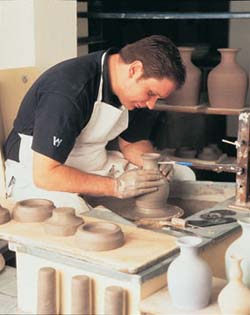 In the years leading up to
the 17th century, European potters were desperate to learn the
secrets of producing fine white porcelain, which had been a
Chinese speciality. The Meissen factory in Germany is usually
credited with discovering the production method, which involves
the fusion of kaolin and alabaster at high temperatures. However
it wasn't long before an English chemist, William Cookworthy,
also determined the technique. After this, the English pottery
factories (which were located around the country) experimented
with the use of burned animal bones as a calcareous flux, and
bone china was born. It remains a very British form of pottery,
sitting alongside more rustic forms such as earthenware and
stoneware. In the years leading up to
the 17th century, European potters were desperate to learn the
secrets of producing fine white porcelain, which had been a
Chinese speciality. The Meissen factory in Germany is usually
credited with discovering the production method, which involves
the fusion of kaolin and alabaster at high temperatures. However
it wasn't long before an English chemist, William Cookworthy,
also determined the technique. After this, the English pottery
factories (which were located around the country) experimented
with the use of burned animal bones as a calcareous flux, and
bone china was born. It remains a very British form of pottery,
sitting alongside more rustic forms such as earthenware and
stoneware.
Wedgwood was quickly followed by the likes of Minton, Copeland,
Spode and Ridgeway. As the popularity of pottery took off (partly
fuelled by the fashionable tea trade from the East Indies), so
too did the number of factories in the Potteries. By the end of
the 19th century over 200 factories were operating in the area.
Some manufacturers were less scrupulous than others and the
copying of designs, names and symbols was widespread. Some
companies had deliberately misleading names such as Vedgewood and
the Dresden Porcelain Company. Even reputable companies
occasionally shared resources -- Thomas Minton is widely credited
with designing the famous 'Willow Pattern' for Spode before going
on to found the company that bears his name. Minton was one of
many companies that specialised beyond the production of
ornamental pieces and tableware, becoming famous for its ceramic
tiles. Another was the Twyford factory in Hanley which became
leaders in the production of sanitary ware for bathrooms.
One of the reasons that production moved to the area from other
areas was the loss of woodland in more rural locations like
Coalbrookdale and Norwich. The availability of coal, together
with ivory clay and red or blue Etruria Marl and water from the
River Trent meant that manufacturers had ready access to all the
resources they were likely to need, including a large labour
force in the urban area.
The success of the potteries around Stoke was a double-edge
sword. Ill health was widespread with diseases like 'potter's
rot' caused by the use of lead glazes. At the start of the 20th
century, over two thousand bottle kilns throughout the city
created a permanent haze of smoke and pollution over the area.
Today most of the bottle kilns have been destroyed and, when
visiting the somewhat sanitised remainders, just how grim working
in them would have been.
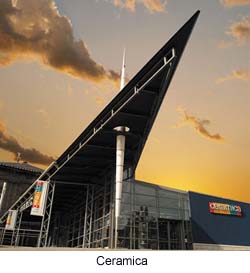 The
bottle kilns themselves were as individual as their owners, with
no two arrangements or designs being quite the same. The kiln
consists of two main parts, the hovel, which is the outer
bottle shaped structure acts as a chimney and protects the oven
inside. This is the kiln itself and is known as the crown.
Crowns are round and their foot-thick walls are strengthened with
iron bands, known as bonts, to protect them from the
forces of firing. Items to be fired were placed in fireclay boxes
called saggars which were stacked to the top of the crown
before the doorway (or clammins) was sealed and the fires
lit. The
bottle kilns themselves were as individual as their owners, with
no two arrangements or designs being quite the same. The kiln
consists of two main parts, the hovel, which is the outer
bottle shaped structure acts as a chimney and protects the oven
inside. This is the kiln itself and is known as the crown.
Crowns are round and their foot-thick walls are strengthened with
iron bands, known as bonts, to protect them from the
forces of firing. Items to be fired were placed in fireclay boxes
called saggars which were stacked to the top of the crown
before the doorway (or clammins) was sealed and the fires
lit.
Bottle kilns were generally fired once a week. The first, or
biscuit, firing took three days and a second firing, known as
glost firing, took two. Kilns never fully cooled and the intense
heat added to the dark and claustrophobic conditions in which
men, known as placers, stacked and replaced the saggars into
towers known as bungs. Temperature control during the
firing was crucial and failure could ruin weeks of work. As well
as the bottle kilns there were other specialist types of kiln,
including Muffle Kilns and Calcining kilns.
In total, over 1,500 potters came and went during the area's
heyday and the reality of life in the potteries and potbanks
(which was though to be a more craftsman-like term than factory)
is easily forgotten in a fog of nostalgia. Brian Bailey
accurately described the city as "having a kind of
self-congratulatory air about its prosperous past."
Not all of Stoke-on-Trent's famous sons are known for their
pottery. One in particular was the novelist, playwright and
essayist Arnold Bennett. He was born into an impoverished
childhood in Hanley in 1867 and set many of his novels in the
'Five Towns', which are drawn from those in Stoke-on-Trent. Keen
eyed readers will have noticed the reference to only five of the
six towns -- for some reason he seems not to have bothered with
Fenton. Many locations can be directly linked with his works,
even although he changed many of the names. Shawport in
the books is Longport, while Hanley became Hanbridge.
Discovering the Past
For visitors who are more interested in learning about the
history of Stoke than picking up a bargain in one of the many
factory shops, then the first port of call has to be the
excellent Gladstone Pottery Museum in Longton. This is
very much a working museum and there are plenty of opportunities
to ask questions of the craftsmen, and women, as you explore 'the
only remaining complete Victorian pottery factory'. As well as
detailed explanations of the key stages involved in pottery
production, there is an excellent exhibition about the
development of the toilet, called unsurprisingly 'Flushed With
Pride.'
Another museum focusing on the 'glory days' of Stoke is the
Etruria Industrial Museum. Featuring Jesse Shirley's Bone
and Flint Mill and located on the Caldon and Trent canals, this
is an ideal compliment to the Gladstone museum. Also worth a look
is The Potteries Museum and Art Gallery.
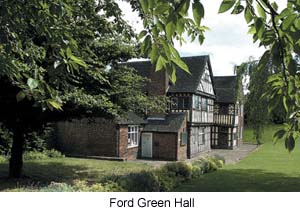 A more modern take on the
areas industry and history is provided at Ceramica in
Burslem, to the north. This is very much a 'hands on' experience
and one that children are sure to love. In three areas, including
Bizarreland, The Pavilions and the Mezzanine you can throw your
own pots, take a magic carpet ride over Burslem, have a go at
firing ceramics and learn about some of the most famous names in
the industry. A more modern take on the
areas industry and history is provided at Ceramica in
Burslem, to the north. This is very much a 'hands on' experience
and one that children are sure to love. In three areas, including
Bizarreland, The Pavilions and the Mezzanine you can throw your
own pots, take a magic carpet ride over Burslem, have a go at
firing ceramics and learn about some of the most famous names in
the industry.
Some of the potteries themselves feature very good museums in
addition to their other facilities with the most well known being
the Spode and Wedgwood visitor centres and the
Dudson Museum. Dudson are the 'oldest surviving family
business in the ceramic tableware industry.' Admission to the
small museum is free, and features include the bottle oven in the
original factory courtyard, where you will find a collection of
Dudson pottery from the firm's two-hundred year history. The
museum is located in Hanley, right in the city centre, making it
ideal for combining with a shopping trip or excursion to the
Cultural Quarter.
For an antidote to the pottery industry visit Ford Green
Hall. This beautiful black and white timber building contains
a number of contemporary collections and allows visitors to
'experience the seventeenth century at close quarters.' The
gardens were planted in 1996 to reflect the gardening styles of
the 1600s when the hall was built and include two knot gardens
and low hedges that mirror the design of the hall's timbers. The
gardens are open throughout the year and admission is free, while
the hall itself is covered by the council's Passport Scheme (see
below).
Modern Stoke
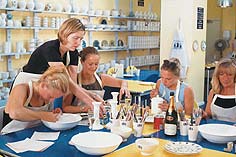 Pottery is still at the heart of the modern tourist
industry in the area and visitors should look out for the
leaflets which provide details of the Ceramic attractions in the
area. These are widely available, but can also be picked up from
the Stoke-on-Trent Touristy Information Centre in Hanley. Pottery is still at the heart of the modern tourist
industry in the area and visitors should look out for the
leaflets which provide details of the Ceramic attractions in the
area. These are widely available, but can also be picked up from
the Stoke-on-Trent Touristy Information Centre in Hanley.
Things to remember when planning any visits include the Factory
Holidays. Details of these dates are available from Tourist
Information, and while most factory shops and museums remain
open, many factory tours will not be available. As always, if in
doubt, check with the company in question. It's worth noting that
some manufacturers have more than one shop in different parts of
the city, and that some shops sell different items to others. For
example, ceramic collectors will love the full price wares on
offer at Royale Stratford and Moorcroft, while seconds and
'utility' quality items are available from many sources. Some
makers, such as Portmeirion, have several shops and separate
'clearance outlets'.
Bridgwater and Royal Stafford have so-called pottery cafes where
children and adults can try their hand at decorating blank pieces
and many factories offer visitor tours of one sort or another,
although some are more frequent than others and some need to be
pre-booked.
Getting There & Getting Around
The nearest airports are Manchester, Nottingham (East Midlands)
and Birmingham, while the city is linked to the motorway network
and the M6 by good main roads. Although the city has a mainline
railway station, it is quite a way from Hanley and the City
Centre. The distance between the furthest attractions is as much
as eleven miles, and the factory shops and museums dotted about
the towns mean that a car is really essential.
It's also useful to note that, like many other areas in the UK,
the four museums that are operated by the City Council (Gladstone
Pottery Museum, The Potteries Museum and Art Gallery, Ford Green
Hall, and Etruria Industrial Museum) operate a combined
'passport' ticket which offers unlimited return visits within a
year and qualifies holders for a discount at some other
attractions.
Other nearby Attractions Stoke's central location
in the west midlands makes it an ideal base to explore further.
To the north-east, the Peak District National Park is only
ten miles away, with numerous attractions including the
Chatsworth estate. Britain's most famous theme park,
Alton Towers is also nearby, as are the exciting gardens
of Bidulph Grange (owned by the National Trust) and
Trentham Gardens, which have recently undergone major
refurbishment.
More Information:
We regret that we no longer have the resources to maintain up-to-date links and/or hours and pricing details for the various sites and attractions listed on this website. For more information about the location(s) listed above, please use your favorite search engine or visit Wikipedia.
Richard Crowhurst is a freelance writer and author based in Lincolshire,
England. He writes on many subjects, including history and heritage topics.
More details can be found on his website, http://www.freelance-writer-and-author.co.uk
Article © 2006 Richard Crowhurst
Photos courtesy of Stoke-on-Trent Tourist Information Office
|
